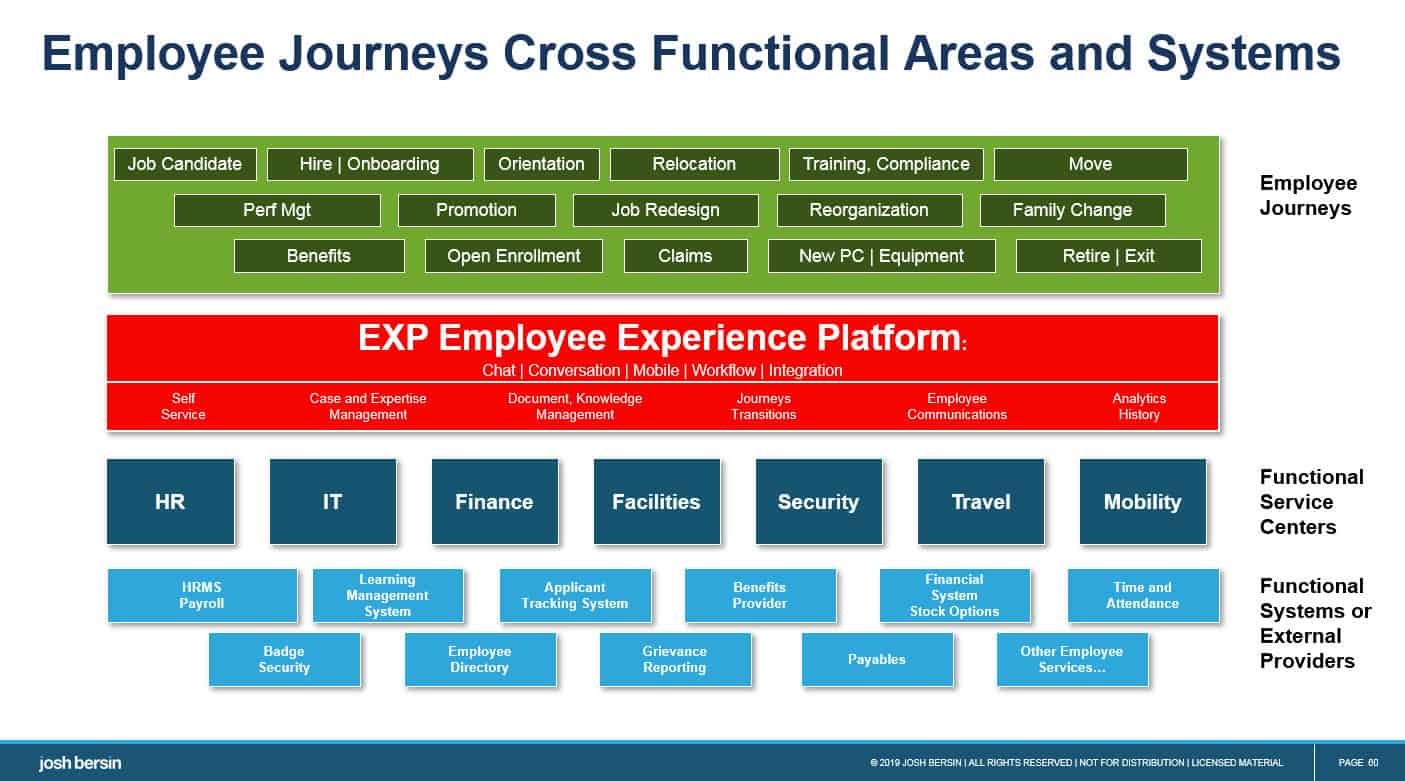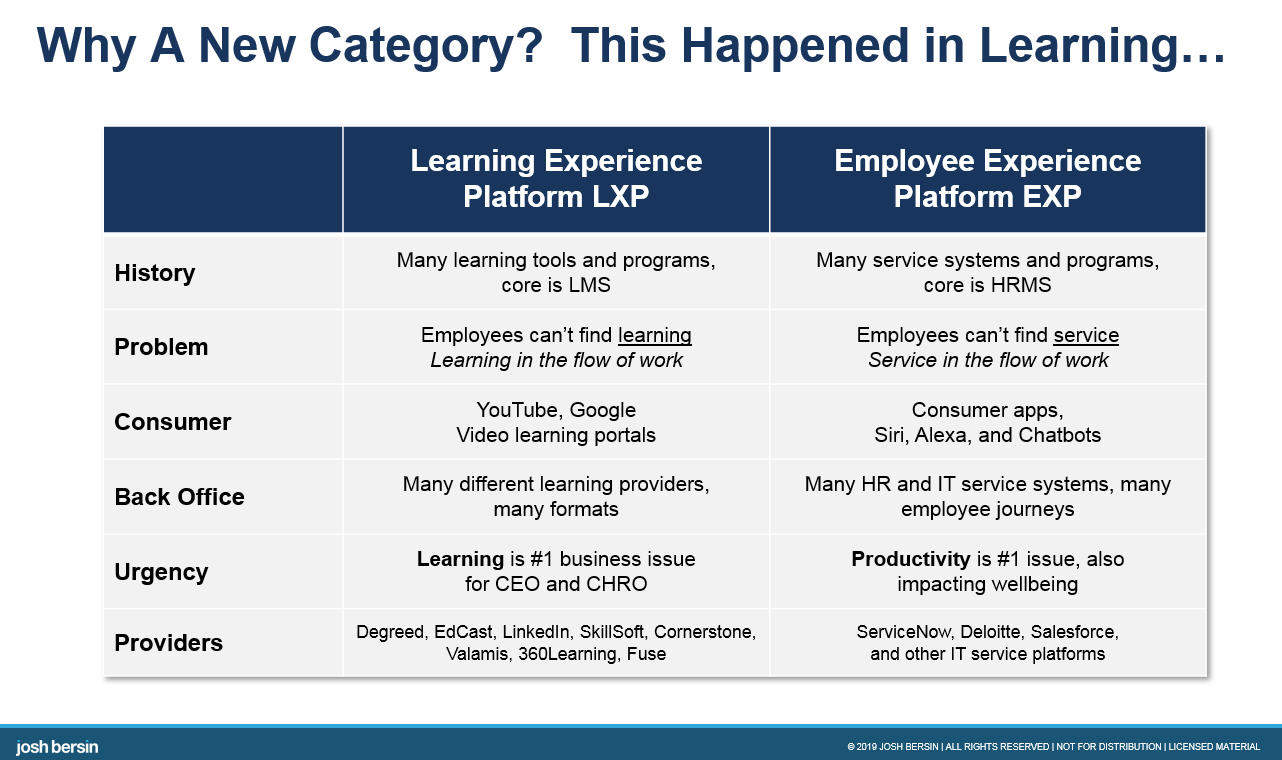The Employee Experience Platform: A New Category Arrives
One of the biggest trends in employment is finding ways to make work easier. In this hot job market employees are quitting their jobs in record numbers, and studies show that the voluntary turnover rate is now over 15%. (This means almost one in six people are leaving their jobs voluntarily to look for another one.)
At the same time, people are working more hours, undergoing more stress, and feel less productive than ever. In fact productivity in all mature economies is slowing (output per hour worked) and most economists can’t even agree on the cause. I believe much of this is just the shift to new digital ways of work, but it’s clear from all my research that much of this is our companies adjusting to a highly networked, contingent, always-on way of getting things done.
 |
HR’s Role In Productivity and Growth
While all this has been going on, HR departments all over the world have been buying new cloud platforms, redesigning performance management, and layering on perks, benefits, and rewards programs to try to make work better.
The escalating war for perks is almost ridiculous to consider. US spending on benefits has skyrocketed to 32% of all payroll spending (over $1 trillion per year in the US), with most of the increase going to healthcare, wellbeing, and better retirement benefits. Companies are being asked to fill in the gaps where our economy has left people behind, and this burden has fallen on HR.
 |
In the middle of all this, we’re buying more and more HR technology to help. The HR tech market is over $8 billion in size and more than $4 billion in venture capital and private equity has been invested. (Just last week a private equity company acquired Ultimate Software for $11 billion in an attempt to make even more money.)
But is all this technology helping?
The answer is “somewhat.” Despite billions of dollars now invested in new cloud-based Human Capital Management Systems (sold by ADP, Ceridian, Oracle, SuccessFactors, Ultimate Software, Workday, and many others), research now shows that the HR tech market is actually getting messier. Yes, most companies are thrilled to have a single system of record at last, and in fact most of these new platforms are replacing older heterogeneous systems that often didn’t even talk with each other.
But as I talk with companies and look at research, I’ve discovered that even after deploying a costly new HCM Platform, companies are still not delivering the employee experience they want. In a study we’re publishing later this year we found that while 59% of companies expected their new platform to be easier to use, only 35% actually achieved that benefit. More and more of organizations tell me “yes we finished the big transformation to Workday | Oracle | SuccessFactors, but we’re still not able to give employees the simplicity they need.”
The problem? The architecture of HR tech changed beneath our feet. The idea that we were going to have a single human capital platform seems to have slipped between our fingers, and in fact, it may not have been a realistic goal in the first place.
Consider the consumer market. Google, Facebook, and Amazon have dozens of back-end systems, yet we see a single easy-to-use interface as consumers. Just as they have abstracted away complexity with a front end layer, so must we build a similar architecture for employees in our companies. This is the world of HR technology and services in the future, and this is why we now need an “Employee Experience Platform.”
HR Technology Architectures Going Forward
Here’s the way all this is playing out.
 |
As this chart shows, there are many employee applications we need in our companies. These range from different recruiting and candidate assessment tools, dozens of tools to find content and learn (the average L&D department has 22, according to Toward Maturity), tools to help with wellbeing, benefits administration, rewards, and many tools for time and attendance, scheduling, employee grievances, moves, family changes, and more. (Just read about some of the hot new wellbeing tools being invented.)
All these wonderful applications do not come from a single vendor. Yes the ERP vendors set out to build them all, but they’ve now realized they can’t keep up with the pace of innovation, so they are repositioning themselves as open platforms. (In June of last year Workday opened up its platform, SAP has invested in its own startup foundry SAP.iO to help fund integrated startups, and Oracle has had its own ISV program for years. This is all in an attempt to maintain their position as the “core system of record.”
I would suggest that even that effort no longer makes sense. Of course, companies want a single HCM system of record, but it’s increasingly hard to keep all that data in one place. So just as Google and Amazon and Facebook integrate your data around your user profile, consolidating data from many applications, we have to do the same in HR. And this means we need a set of software to deliver a single user interface; something that lets us build employee journeys, develop apps, create and monitor workflows, and add chatbots and other forms of conversational interfaces to the mix.
And companies have to accept that innovation is not slowing down. While the large HCM vendors have great systems, HR teams are always searching for the “next big thing” in AI-driven recruitment, career management, learning, wellbeing, or pay. We need an architecture that facilitates and supports this level of innovation, without constantly interrupting employees with “another tool to use.”
The answer is a set of software I call the Employee Experience Platform. Just as middleware products exploded with growth in the last decade, so this market for a user-centric software layer is exploding in the world of HR. And this is not just a good idea: it’s happening today.
I went to the ServiceNow user conference last Fall, for example, and found 14,000+ companies there all searching for tools to integrate their entire end-to-end employee service experience. Yes this is largely focused on “service delivery” today, but over time I believe more and more employee applications and journeys will be developed in these systems.
Consider an application like onboarding. Every company needs to capture employee W-9 data, provision an email address and PC, send them instructions for their badge and security procedures, introduce the employee to their team and job, and of course teach them how to get paid, submit time cards, take vacation, and on and on. And then there’s the whole topic of teaching this new employee how to work in our company, giving them a sense of community, and showing them where to go for help.
I went through an entire week of this at Deloitte (on-site in Dallas) and at the end of the week I forgot almost everything I learned. If there was a “system” or “app” that brought this together into one workflow, I’d probably be using it my entire first year in the company. Well that’s a perfect application for the EXP. The EXP is a platform that lets a company design this multi-step, multi-flow experience, integrate it with all the various IT and HR applications needed, and abstract the user from the complexity behind the scenes. If the company switches out LMS systems, the employee never knows.
In many ways the EXP is the next generation of the “employee portal,” which most companies build by hand.
If you look at the biggest ERP HCM implementations around the world, almost all these companies reach the conclusion that they need an EXP. The biggest players in this market are ServiceNow, WillisTowersWatson, IBM, Deloitte, and many others entering the scene. But it’s clear to me this is going to be big.
Why A New Platform
The big question we have to answer is “why a new platform?” Why don’t we just buy a lot of tools to string this all together?
Well, that’s what’s happening now, and as most software veterans know, when there’s a vacuum in the market, vendors will fill it.
The key vendors playing in this market today include ServiceNow, TowersWatson, Deloitte (ConnectMe), PeopleDoc (owned by Ultimate), Ti-People, PeopleSpheres, GuideSpark, Spencer.co, and IBM. And one could also argue that intelligent chatbot companies like Mya, Leena, WorkGrid, and new chat tools being embedded into core HCM platforms are also part of this market. And there will be many more.
If you look at the picture above, you can see that the EXP market is going to be broad. IBM, which offers a wide range of cognitive tools, has intelligent chatbots which can help you find your next job, automatically target your resume toward the right open position, and intelligently answer questions from Workday or SuccessFactors. Mya, the leader in recruitment-oriented intelligence, can automatically schedule interviews and help screen and assess candidates. And tools like Leena and many others give employees quick answers to regularly asked questions.
My point here is not to give you an exhaustive list of vendors in this space, but rather explain that employee experience platforms are important, and they are going to be independent of your ERP.
WillisTowersWatson, for example, has helped hundreds of companies develop easy-to-use portals that sort out the complex, messy process of identifying various benefits plans, connecting to the right provider, and submitting claims. GuideSpark has built a process-based system to help you learn about almost any employee benefit and program, again independent of the back-end system.
Think about it this way. As we’ve moved from “point solutions” in HR to integrated, end-to-end employee experiences, so must we move from transactional systems to what I call “systems of productivity” or systems that make an employee’s work-life easier. New enterprise software categories emerge because they address unsolved problems, and that’s precisely what’s happening.
 |
There are many implications of this change, the not least of which is the fact that silo’d service centers also have to go away.
If you build an employee experience that includes provisioning a new PC, setting up new payroll and expense processing, introducing employees to their team, and then giving them an onboarding and new hire training program – that has to include IT, HR, and Finance support. In the new world of integrated employee experiences, these back end support centers have to be interconnected and integrated as cross-functional teams.
Last week I spent some time with Diane Gherson the CHRO of IBM. She shared that over the last seven years IBM has reduced HR spending by almost 40% through automation, intelligent systems, chat bots, and more predictive applications. She’s done this while replacing the core ERP (and shutting off the LMS) behind the scenes, shielding IBM employees from seeing the complexity. IBM is now selling solutions to help companies do this for themselves.
(Just as Ultimate Software acquired PeopleDoc, I could easily see the ERP HCM providers building or acquiring tools to build out the red layer above.)
Changing The Service Delivery Model
Perhaps the biggest trend behind this new category is the way service delivery models are changing. In the last decade we’ve spent billions of dollars creating HR service centers, centers of excellence, and business partner roles that stitch this together for employees. In the future, as more employee journeys are automated and instrumented in these platforms, the HR service center has to become a multi-functional solution. HR problems are now coupled with IT and Finance solutions, and the employee experiences the service center during a journey (not during a transaction.)
This means doing much more work to interconnect and redefine your service teams so they understand these journeys and can address all the touch points. This is an opportunity for HR to dramatically reduce the cost of support while simultaneously improving the employee experience – and the HR business partners and local HR VPs can truly become business advisors.
All this is part of what I’d like to call HR 3.0 (which I’ll be covering later this year), which we discussed with IBM just this week. Let me just assure you that a whole new operating model for HR is emerging, and it’s one that will be even more AI-powered, more data-driven, and more experiential and productive for employees. (One of my friends calls it Cognitive Enterprise Service Management.)
 |
An Example Where This Happened: Learning Experience Platforms
There’s much more to talk about on this topic, so I encourage you to read the whitepaper. But let me leave you with one final thought. This precise transition just exploded in the L&D market, where the Learning Experience Platform space has exploded to replace and complement the LMS market. As the chart below illustrates, we can see the same thing happening here.
 |
The LMS is not “going away” but it’s quickly being repositioned as an important transactional system. The same thing is happening across all areas of HR.
My recommendation to you as an HR professional is to look at these new systems as among the most important new applications you buy. They are the way you engage with your employees, built new easy-to-use solutions, and help keep employees from continuous change management as back-office systems change. And with journey maps, process management, and new chat and cognitive tools, they will help your employees have a more productive and engaging experience than ever before.
Click here to download the whitepaper. As always I welcome your feedback. (Click on the image below to receive the whitepaper.)
 |


